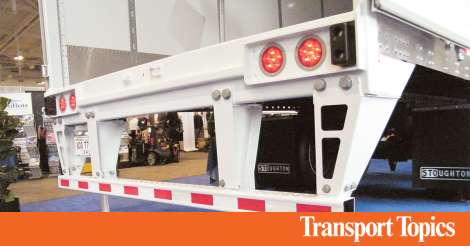
(Transport Topics)
[Stay on top of transportation news: Get TTNews in your inbox.]
The National Highway Traffic Safety Administration has denied a petition from four individuals asking it to further toughen existing U.S. rear underride guard requirements to a level beyond the strict levels currently in place in Canada.
“The agency is denying the petition because it does not provide new or different information that would warrant initiation of a rulemaking at this time,” NHTSA said in a July 15 Federal Register post. The petition was filed Aug. 18, 2022, by Jerry and Marianne Karth, Eric Hein and Lois Durso-Hawkins, parents who have lost children in underride crashes. The petition was dated roughly one month after NHTSA issued an updated rear guard standard.
The current NHTSA standard was adopted about 6½ years after the agency in December 2015 proposed that the rule be updated. The agency in its July 2022 rule update adopted requirements similar to Transport Canada’s standard for rear impact guards. That standard provides sufficient strength and energy absorption to protect occupants of compact and subcompact passenger cars impacting the rear of trailers at 35 mph.
“This final rule provides upgraded protection in crashes in which the passenger motor vehicle hits the rear of the trailer or semitrailer such that 50% to 100% of the width of the passenger motor vehicle overlaps the rear of the trailer or semitrailer,” the agency wrote at the time.
In support of their petition, the petitioners stated that NHTSA had been directed by Congress to “protect the safety of the driving public against unreasonable risk of death or injury” and claimed that the agency had failed to fulfill these directives with the 2022 update. They noted NHTSA’s “acknowledgment that [the final rule] is a minimum standard” but asserted that it “lacks a genuine commitment to the Department of Transportation’s National Roadway Safety Strategy.”
The petitioners stated that there is much debate about the frequency of underride crashes, including those at the 30% offset. These are defined as crashes in which 30% of the car’s width overlaps the rear of the truck, rather than striking the truck in the center of the rearguard. The petitioners maintained that 30% overlap crashes more often result in more severe injuries due to the failure of the guard and passenger compartment intrusion, and that the agency’s reasons for not adding a requirement are “incongruous and unfounded.”
The petitioners also said that NHTSA should require that regulations for rear impact guards receive the Insurance Institute for Highway Safety’s ToughGuard award — trailers that pass all three of the group’s tests of car strikes at full width, and 50% and 30% overlap. The petitioners disagreed with NHTSA’s decision that additional research was needed before adding a 30% overlap requirement.
“An underride collision occurs when a semitrailer collides with a passenger vehicle causing the passenger vehicle to slide under the body of a semitrailer, often crushing the vehicle and passengers within, or dragging the vehicle causing it to burn with passenger inside,” the petition said. “Due to the height difference between passenger vehicles and semitrailers, a collision bypasses the car’s safety features because the point of impact is the passenger compartment, not the front bumper of the car.”
However, the petition alleged that federal crash records do not always record “hundreds of deaths and thousands of injuries annually in underride collisions.”
The petition denial comes only days after a majority report of a divided specially appointed federal committee on trailer underride protection that called on regulators to make so-called urgent and sweeping safety regulatory actions.
Two trucking industry trade groups criticized the report as lacking in true consensus across the full committee, noting that the report recommended a variety of actions to launch that the two groups and others stressed are impractical and lack support among key stakeholders.
Included in the report — supported by a slim majority of committee members — was a recommendation to launch a rulemaking to consider mandating side underride guards on heavy trucks.